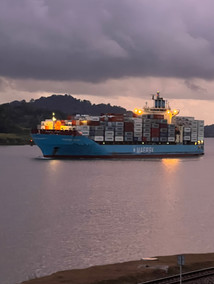The Panama Canal - an engineering marvel for its time
- bstclair579
- Mar 13, 2024
- 3 min read
Updated: Apr 10, 2024
The Panama Canal surprised me about how interesting it is. It truly is a an engineering marvel for its time. It has been considered as one of the Seven Wonders of the Modern World.
The canal is an 82-kilometer waterway connecting the Pacific and Atlantic oceans. It greatly reduced the expense and hazards of rounding the southern tip of South America. It includes a series of locks and a large man-made lake, Gatun Lake, the largest dam and man-made lake in the world at the time.
Thoughts of a canal across the isthmus of Panama date back to as early as 1534 when Charles V, King of Spain, ordered a survey. At the time, gold and silver from the Spanish conquest of the Incas was carried overland from Panama City to ports at Nombre de Dios and then Portobello on the Caribbean coast. It would remain that way for the next almost 400 years. The United States negotiated a deal with Gran Columbia in 1826 to build a canal, but that deal fell through. In 1843 Great Britain entered into a contract for a canal, but the plans were not carried out. The 1849 the California Gold Rush led to greater interest in travel across the isthmus to shorten the time between East Coast and California, leading to the completion of a railroad by the United States in 1855, greatly facilating trade and travel.
The first attempt to construct a canal was carried out by the French between 1881 and 1899. The French had great success building the Suez Canal, but were unprepared for the challenges of the tropical climate, rainforests, much more challenging terrain, and tropical diseases. It is estimated that 22,000 men died from disease and accidents. The effort eventually went bankrupt. But it was a blueprint for the next effort by the United States.
The United States attempted to negotiate a deal with Columbia to build the canal, but was unsuccessful. This lead to United States support for the separation of Panama from Columbia in 1903 and some underhanded dealing that led to a treaty granting the United States rights to build the canal and have jurisdication over a 5-mile strip of land on either side of the waterway. The deal was immediately contentious with Panamanians as an infringement on their sovereignty (and a raw deal), and would remain so until the signing of the Torrijos-Carter treaty in 1977 leading to the handover of the canal to Panama by 1999.
Building the canal was a monumental effort. Besides great ingenuity and logistics, it involved a large workforce, up to 40,000 people at a time. They were mostly from the British West Indies (Barbados and Jamaica), but also from Spain, Italy, and Asia, as well as the United States. Many of the West Indies workers stayed in Panama and now contribute greatly to the diversity of Panama City and Colon. Critical to the success of the project were efforts to minimize the spread of diseases, especially malaria and yellow fever which were at that time found to be carried by mosquitos. Despite mosquito control and improved sanitation and housing, about 5,600 people died from disease and accidents, and many more permanently disabled. The construction of the canal was completed by 1914.
Rising demand in global shiipping led the government of Panama to propose a new set of locks designed for larger ships. Construction began in 2007 and was completed in 2016, doubling the capacity of the Panama Canal. Today the Panama Canal is a major economic driver for Panama. Climate change leading to increased droughts, however, poses a risk to the capacity of the canal. Panama Canal traffic has been slashed for the first time by a third this year because there is not enough water to operate the locks due to drought in 2023.
I enjoyed watching ships cruise by in the evening in Gamboa. After Sheri arrived, we went to the Miraflores Locks, where there is a wonderful visitor center with a great Imax movie. I also visited the Canal Museum in Casco Viejo where I learned much about the history including the recent history of student protests in the 1960s, the rising dictatorship that eventually led to the administration of Manuel Noriega and his downfall, and the current state of the canal and its importance to Panama and the world.






















nice to hear at least one comment about climate change! :-)